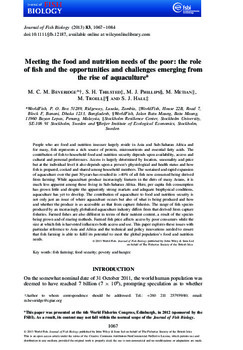Please use this identifier to cite or link to this item:
https://hdl.handle.net/20.500.12348/913
Meeting the food and nutrition needs of the poor: the role of fish and the opportunities and challenges emerging from the rise of aquaculture

Abstract
- People who are food and nutrition insecure largely reside in Asia and Sub-Saharan Africa and for many, fish represents a rich source of protein, micronutrients and essential fatty acids. The contribution of fish to household food and nutrition security depends upon availability, access and cultural and personal preferences. Access is largely determined by location, seasonality and price but at the individual level it also depends upon a person's physiological and health status and how fish is prepared, cooked and shared among household members. The sustained and rapid expansion of aquaculture over the past 30 years has resulted in >40% of all fish now consumed being derived from farming. While aquaculture produce increasingly features in the diets of many Asians, it is much less apparent among those living in Sub-Saharan Africa. Here, per capita fish consumption has grown little and despite the apparently strong markets and adequate biophysical conditions, aquaculture has yet to develop. The contribution of aquaculture to food and nutrition security is not only just an issue of where aquaculture occurs but also of what is being produced and how and whether the produce is as accessible as that from capture fisheries. The range of fish species produced by an increasingly globalized aquaculture industry differs from that derived from capture fisheries. Farmed fishes are also different in terms of their nutrient content, a result of the species being grown and of rearing methods. Farmed fish price affects access by poor consumers while the size at which fish is harvested influences both access and use. This paper explores these issues with particular reference to Asia and Africa and the technical and policy innovations needed to ensure that fish farming is able to fulfil its potential to meet the global population's food and nutrition needs.
Collections
View/
Date
- 2013
Author
-
Beveridge, M.
-
Thilsted, S.H.
-
Phillips, M.
-
Metian, M.
-
Troell M.
-
Hall, S.J.
Author(s) ORCID(s)
- Michael Phillipshttps://orcid.org/0000-0002-0282-0286
AGROVOC Keywords
Type
- Journal Article
Publisher
- Wiley
